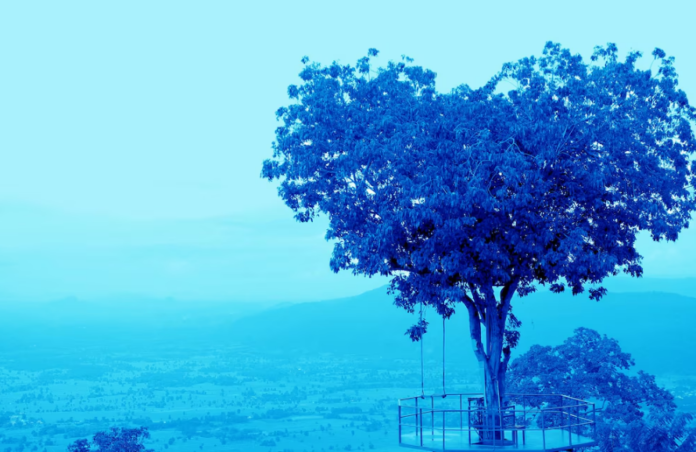When you think of trees, vibrant greens and earthy browns likely come to mind. But have you heard of the enigmatic blue tree? A vibrant spectacle in nature, blue trees seem like something out of a fairytale. These striking natural wonders captivate environmental enthusiasts, nature lovers, and eco-friendly consumers alike. Beyond their otherworldly appearance, blue trees play an essential role in biodiversity and provide inspiration in art and culture.
In this blog, we’ll explore the science behind blue trees, their environmental impact, cultural significance, the challenges they face, and how you can contribute to their conservation.
The Blue Tree Phenomenon
What Makes a Tree Blue?
Blue trees are not science fiction—they are a stunning reality. Found in certain habitats across the globe, the unique hues of blue trees are often due to structural coloration and light reflection rather than pigmentation. For example, species like the Blue Quandong (Elaeocarpus angustifolius) and the Blue Spruce (Picea pungens) exhibit these vibrant tones.
The bluish tint is often the result of a waxy coating on their leaves or needles. This coating reflects light in a way that appears blue and serves a functional purpose in nature, such as protecting the foliage from harmful UV rays or reducing water loss in hot climates.
Where Can You Find Blue Trees?
Blue trees are most commonly found in specific regions, thriving in unique habitats that support their growth. The Blue Quandong is native to rainforests in Australia and Southeast Asia, while the Blue Spruce is widely found in North American forests. These trees not only add aesthetic value to their ecosystems but also play critical environmental roles.
The Environmental Impact of Blue Trees
Guardians of Biodiversity
Blue trees are more than just beautiful—they are fundamental to biodiversity. Species like the Blue Quandong produce nutrient-rich fruits that provide food for native wildlife, including birds and mammals. By supporting the food chain, they maintain ecological balance in their natural habitats.
Blue Spruces, meanwhile, contribute to forest ecosystems by acting as habitats for small animals and birds, as well as providing shade and improving soil health. Every blue tree you see plays a part in sustaining life around it.
Climate Change Warriors
Much like their green counterparts, blue trees are active participants in fighting climate change. By absorbing CO2 and releasing oxygen, they help mitigate the impacts of global warming. They also influence local climates by reducing the heat island effect—especially in urban environments—when planted in cityscapes.
Cultural and Artistic Significance
A Source of Timeless Inspiration
Blue trees have found their way into art, design, and cultural symbolism. Historically, their otherworldly hue inspired folklore and myths, often representing mystery and serenity. They are also frequently referenced in modern art and media, serving as symbols of uniqueness and beauty.
One notable cultural initiative is “The Blue Trees” project by artist Konstantin Dimopoulos. This public art installation involves painting trees blue with bio-safe pigments to raise awareness about deforestation and the importance of global conservation efforts.
Blue in Design
The color blue has a calming and trustworthy presence, which has made blue trees a source of inspiration in landscape design and urban planning. Their presence adds not just to the aesthetic appeal but also to the emotional resonance of spaces.
Threats and Conservation Efforts
Current Challenges Facing Blue Trees
Despite their resilience, blue trees face significant threats. Rapid deforestation for agriculture, urbanization, and industry has led to habitat loss, leaving many species vulnerable to extinction. Climate change further exacerbates these threats, as shifts in temperature and weather patterns disrupt the delicate balance of ecosystems where blue trees thrive.
Additionally, invasive species and human interference, such as illegal logging, pose challenges to the survival of these natural wonders.
Conservation in Action
The good news is that conservation efforts are underway. Organizations worldwide are working to protect blue tree habitats through reforestation programs, legal protections, and public education campaigns. Local initiatives often focus on planting native blue tree species, creating wildlife corridors, and raising awareness about their ecological importance.
Engaging the Community
How You Can Make a Difference
Protecting blue trees—and the environment in general—requires collective effort. Here are some ways you can get involved:
- Participate in Reforestation Programs: Join organizations working to plant native blue tree species and restore damaged ecosystems.
- Support Ethical Forestry Practices: Purchase products certified by organizations like the Forest Stewardship Council (FSC), which ensures sustainable logging practices.
- Raise Awareness: Share the story of blue trees within your community. Join and support initiatives like “The Blue Trees” art project to amplify the cause.
Local and Global Initiatives
If you’d like to take it a step further, look into becoming involved with global conservation efforts. Organizations such as the World Wildlife Fund (WWF) and local environmental groups often run campaigns to address deforestation and promote biodiversity. Wherever you live, there’s a way to connect with like-minded environmental advocates.
Why Blue Trees Matter—Now More Than Ever
Blue trees remind us of the beauty and diversity of our planet—and the urgency of protecting it. Beyond their striking appearance, these trees provide critical ecological benefits, sustain biodiversity, and inspire cultural and artistic expression.
But they can’t protect themselves. Now is the time to act. Whether you’re planting trees, reducing your environmental footprint, or spreading awareness, every small effort contributes to preserving these treasures for future generations.
Ready to get started? Join a conservation initiative or plant your own blue spruce. Together, we can ensure that blue trees—and the ecosystems they support—continue to thrive for years to come.



